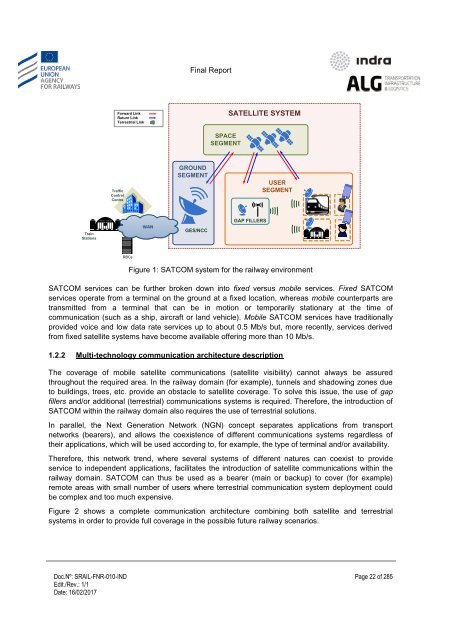Study on feasibility of SATCOM for railway communication
SRAIL-FNR-010-IND%20-%20FinalReport_v1.1_20170216
SRAIL-FNR-010-IND%20-%20FinalReport_v1.1_20170216
Create successful ePaper yourself
Turn your PDF publications into a flip-book with our unique Google optimized e-Paper software.
Final Report<br />
Forward Link<br />
Return Link<br />
Terrestrial Link<br />
SATELLITE SYSTEM<br />
SPACE<br />
SEGMENT<br />
Traffic<br />
C<strong>on</strong>trol<br />
Centre<br />
GROUND<br />
SEGMENT<br />
USER<br />
SEGMENT<br />
Train<br />
Stati<strong>on</strong>s<br />
WAN<br />
GES/NCC<br />
GAP FILLERS<br />
RBCs<br />
Figure 1: <strong>SATCOM</strong> system <strong>for</strong> the <strong>railway</strong> envir<strong>on</strong>ment<br />
<strong>SATCOM</strong> services can be further broken down into fixed versus mobile services. Fixed <strong>SATCOM</strong><br />
services operate from a terminal <strong>on</strong> the ground at a fixed locati<strong>on</strong>, whereas mobile counterparts are<br />
transmitted from a terminal that can be in moti<strong>on</strong> or temporarily stati<strong>on</strong>ary at the time <strong>of</strong><br />
communicati<strong>on</strong> (such as a ship, aircraft or land vehicle). Mobile <strong>SATCOM</strong> services have traditi<strong>on</strong>ally<br />
provided voice and low data rate services up to about 0.5 Mb/s but, more recently, services derived<br />
from fixed satellite systems have become available <strong>of</strong>fering more than 10 Mb/s.<br />
1.2.2 Multi-technology communicati<strong>on</strong> architecture descripti<strong>on</strong><br />
The coverage <strong>of</strong> mobile satellite communicati<strong>on</strong>s (satellite visibility) cannot always be assured<br />
throughout the required area. In the <strong>railway</strong> domain (<strong>for</strong> example), tunnels and shadowing z<strong>on</strong>es due<br />
to buildings, trees, etc. provide an obstacle to satellite coverage. To solve this issue, the use <strong>of</strong> gap<br />
fillers and/or additi<strong>on</strong>al (terrestrial) communicati<strong>on</strong>s systems is required. There<strong>for</strong>e, the introducti<strong>on</strong> <strong>of</strong><br />
<strong>SATCOM</strong> within the <strong>railway</strong> domain also requires the use <strong>of</strong> terrestrial soluti<strong>on</strong>s.<br />
In parallel, the Next Generati<strong>on</strong> Network (NGN) c<strong>on</strong>cept separates applicati<strong>on</strong>s from transport<br />
networks (bearers), and allows the coexistence <strong>of</strong> different communicati<strong>on</strong>s systems regardless <strong>of</strong><br />
their applicati<strong>on</strong>s, which will be used according to, <strong>for</strong> example, the type <strong>of</strong> terminal and/or availability.<br />
There<strong>for</strong>e, this network trend, where several systems <strong>of</strong> different natures can coexist to provide<br />
service to independent applicati<strong>on</strong>s, facilitates the introducti<strong>on</strong> <strong>of</strong> satellite communicati<strong>on</strong>s within the<br />
<strong>railway</strong> domain. <strong>SATCOM</strong> can thus be used as a bearer (main or backup) to cover (<strong>for</strong> example)<br />
remote areas with small number <strong>of</strong> users where terrestrial communicati<strong>on</strong> system deployment could<br />
be complex and too much expensive.<br />
Figure 2 shows a complete communicati<strong>on</strong> architecture combining both satellite and terrestrial<br />
systems in order to provide full coverage in the possible future <strong>railway</strong> scenarios.<br />
Doc.Nº: SRAIL-FNR-010-IND<br />
Edit./Rev.: 1/1<br />
Date: 16/02/2017<br />
Page 22 <strong>of</strong> 285


